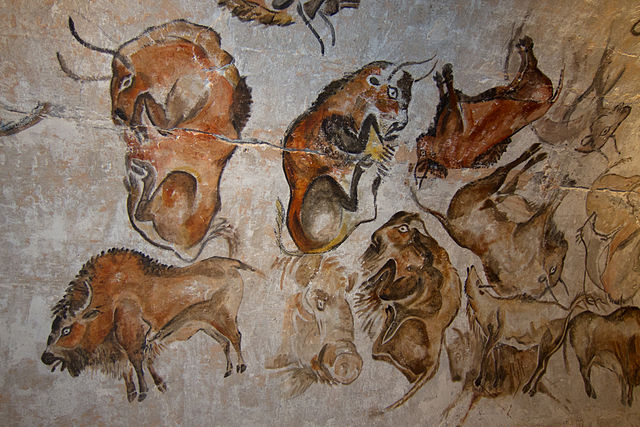17. The Cognitive Revolution (~70 – 30 ka)
Summary Since about 70,000 years ago individuals of our species Homo sapiens learned to efficiently communicate and to flexibly cooperate with each other, using sophisicated languages. In the wake of this Cognitive Revolution our species invented several techniques, created the first art objects, started to engage in long-distance trade and spread from Africa to Eurasia, to Australia and to the Americas. This global expansion of our species with its advanced languages led to the extinction of all other human species and of many other large mammal species.
Keywords Globalization; Ice Age; Languages; Mass Extinction; Technology

A cave painting showing bisons from the Cave of Altamira in Spain, painted about 20,000 years ago. (© Photographed by Thomas Quine / Wikimedia Commons / CC-BY-SA-2.0)
From about 70,000 to 30,000 years ago the behavior of Homo sapiens changed dramatically, an event which was called the Cognitive Revolution by historian Yuval Noah Harari. During that time individuals of Homo sapiens, in the following called modern humans, started to use sophisticated languages to communicate with each other. Modern humans started to efficiently share information and to imagine abstract things which do not really exist, which led to the creation of the first art objects such as cave paintings and figurines from that era. The usage of language and a shared imagination enabled modern humans to cooperate with each other in a fast-changing flexible way, adapted to their respective environments, in contrast to other animals whose behavior was and is largely determined by their slowly-changing DNA. The flexible cooperative behaviors of modern humans are called cultures, and their emergence in the time of about 70,000 to 30,000 years ago marks the point when human history loosened its shackles from biology.
In that time modern humans started to use oil lamps, needles which were needed for sewing warm clothing, and bows and arrows. Some modern humans started to construct boats and settled in early fishing villages. They engaged in long-distance trade of rare goods such as obsidian and seashells – something which for example Homo neanderthalensis never did. What is maybe most remarkable is that early human hunting techniques became more sophisticated which catapulted them to the top of the food chains.
All these developments took place within the Last Glacial Period which lasted from about 115,000 to 11,700 years ago. During the Last Glacial Maximum of about 22,000 years ago, which was the coldest time during the Last Glacial Period, the average global temperature was about 6 degree Celsius colder than today. Additionally, the global sea level was more than 100 meters lower than today, as much of today’s oceanic water was bound in ice sheets.

Since about 100,000 years ago our species Homo sapiens (red) spread from Africa to Eurasia, and then to Australia and to the Americas. Its expansion was the primary reason for the extinction of all other human species – such as Homo neanderthalensis (yellow) and others (green) – and of many other large terrestrial mammals. (© User:Altaileopard / Wikimedia Commons / Public Domain)
During modern humans started to use a sophisticated language and invented several new technologies, they spread from Africa to Eurasia since about 100,000 years ago. They settled in all areas which were previously inhabited by other human species, from Europe in the west to China and Indonesia in the east. While it seems that modern humans occasionally interbred with other human species, with one example being Homo neanderthalensis, the main effect of the expansion of modern humans on other human species was their extinction. Homo neanderthalensis in Europe and western Asia went extinct about 30,000 years ago, and the last other human living species on Earth Homo floresiensis in Indonesia – the “hobbits” which only grew about 1.1 meters tall – went extinct 13,000 years ago. Since that time our species Homo sapiens is the only living human species on Earth.
Around 50,000 years ago modern humans reached Australia by boat, which was the first time that humans left the Afro-Eurasian ecological system. This human expansion to Australia coincided with the extinction of most of the Australian megafauna, certainly as the result of overhunting by humans with their shrewd hunting techniques. Also the large-scale burning of forests by humans might have played a role. Another large mass extinction occurred in the Americas after modern humans had reached there via the Beringia land bridge between northeastern Siberia and northwestern Alaska about 16,000 years ago. Human survival in the far north required the usage of snowshoes and effective thermal clothing. About 12,000 years ago humans reached the southern tip of south America. Similar human-caused extinctions on smaller scales followed later in Madagascar around 500 CE and in New Zealand around 1200 CE.
Overall, from the beginning of the Cognitive Revolution about 70,000 years ago to the beginning of the Agricultural Revolution about 12,000 years ago about half of the large terrestrial mammals heavier than 50 kg went extinct, with a few examples being elephant-like mammoths, the largest ever-living marsupials in Australia which are called diprotodons, and saber-toothed cats. The extinction of animals, however, would also continue after the advent of the Agricultural Revolution and continue until the present day.
